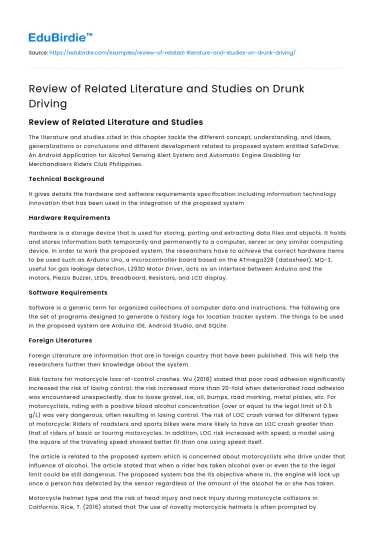Introduction
Drunk driving remains a critical public safety issue worldwide, with significant societal and economic implications. This essay seeks to review the existing literature and studies on drunk driving, focusing on its causes, impacts, and preventive measures. Despite stringent laws and awareness campaigns, driving under the influence (DUI) continues to contribute to a substantial number of road accidents and fatalities. According to the World Health Organization (WHO), approximately 1.35 million people die each year as a result of road traffic crashes, with a significant portion attributable to alcohol impairment. The review will explore diverse perspectives, including psychological, legal, and sociocultural factors influencing drunk driving behavior. By synthesizing various studies, this essay aims to provide a comprehensive understanding of the multifaceted nature of this issue and propose potential strategies for mitigation.
Psychological and Behavioral Aspects of Drunk Driving
The psychological and behavioral dimensions of drunk driving are crucial to understanding why individuals engage in such risky behavior despite the known hazards. Research indicates that alcohol impairs cognitive functions, decreasing an individual's ability to judge distances and react swiftly to changing road conditions. A study by Fillmore and Vogel-Sprott (1999) highlights that alcohol consumption leads to overconfidence in driving abilities, reducing the perceived risk of driving while intoxicated. This cognitive dissonance between perceived and actual ability is exacerbated by social and cultural factors that sometimes glorify alcohol consumption.
Save your time!
We can take care of your essay
- Proper editing and formatting
- Free revision, title page, and bibliography
- Flexible prices and money-back guarantee
Moreover, behavioral theories, such as the Theory of Planned Behavior, suggest that attitudes towards drunk driving, perceived social norms, and perceived behavioral control significantly influence an individual's intention to drive under the influence. For instance, individuals who frequently observe peers engaging in drunk driving might develop a normative belief that such behavior is acceptable. Counterintuitively, punitive legal measures alone have proven insufficient in curbing this behavior. As noted by Babor et al. (2010), comprehensive interventions that include educational programs and community-based initiatives tend to be more effective in altering these deep-seated behaviors.
To bridge these gaps, some studies recommend the integration of psychological interventions in DUI prevention programs. These interventions could focus on enhancing self-awareness and self-regulation skills, potentially reducing the likelihood of driving under the influence. A multi-faceted approach that combines legal measures with psychological insights appears to be a promising direction for future research and policy development.
Legal Framework and Policy Interventions
The legal framework surrounding drunk driving varies significantly across jurisdictions, yet the underlying objective remains consistent: to deter individuals from driving while impaired. Many countries have implemented strict blood alcohol concentration (BAC) limits, with severe penalties for offenders. For instance, the United States has set a standard BAC limit of 0.08%, with some states adopting lower thresholds for commercial drivers and repeated offenders. Research by Fell and Voas (2006) supports the effectiveness of legal deterrents, noting a decline in alcohol-related crashes following the implementation of stricter BAC laws.
However, the enforcement of these laws is often inconsistent, which undermines their potential efficacy. Studies have shown that random breath testing and sobriety checkpoints can significantly deter drunk driving when consistently applied. For example, a study conducted in Australia demonstrated a 22% reduction in alcohol-related crashes following the introduction of random breath testing (Henstridge et al., 1997). Yet, the success of such measures heavily relies on public perception and the perceived likelihood of being caught.
Furthermore, innovative policy interventions, such as the introduction of ignition interlock devices, have shown promise in preventing repeat offenses. These devices require drivers to pass a breathalyzer test before the vehicle can start, effectively reducing recidivism among DUI offenders. While these measures are effective, their implementation must be accompanied by public education campaigns to ensure widespread compliance and understanding of the risks associated with drunk driving.
Sociocultural Influences and Counter-Arguments
Sociocultural factors play a pivotal role in shaping attitudes towards drunk driving. In many cultures, alcohol consumption is deeply ingrained in social rituals and celebrations, which can inadvertently normalize intoxicated driving. According to research by Greenfield and Room (1997), societal attitudes towards alcohol and driving heavily influence individual behavior and policy effectiveness. For instance, in societies where alcohol is widely consumed and accepted, DUI laws may face resistance or lack robust enforcement.
Counter-arguments often arise regarding the infringement of personal freedoms and the economic implications of strict DUI laws. Critics argue that stringent regulations could impact the hospitality and tourism industries, where alcohol plays a central role. However, the counterbalance to such arguments lies in the overwhelming evidence of the human and economic costs associated with drunk driving accidents. The National Highway Traffic Safety Administration (NHTSA) estimates that alcohol-impaired driving costs the United States approximately $44 billion annually, a figure that starkly highlights the necessity of stringent DUI laws.
Addressing these sociocultural challenges requires a nuanced approach that respects cultural practices while prioritizing public safety. Tailored awareness campaigns that resonate with specific cultural contexts and emphasize the personal and societal consequences of drunk driving can enhance the effectiveness of legal measures. By acknowledging and addressing these counter-arguments, policymakers can develop more comprehensive and culturally sensitive strategies to combat drunk driving.
Conclusion
In conclusion, the review of literature and studies on drunk driving underscores the complexity of this pervasive issue. Psychological, legal, and sociocultural factors intricately interact, influencing individual behavior and societal norms. Effective interventions require a multi-faceted approach that combines stringent legal measures with psychological insights and sociocultural awareness. While significant progress has been made in reducing the incidence of drunk driving, continuous efforts are necessary to address emerging challenges and adapt strategies to evolving societal dynamics. Future research should focus on developing innovative interventions and evaluating their efficacy in diverse cultural contexts. By fostering a holistic understanding of the factors contributing to drunk driving, society can move closer to mitigating this critical public safety issue.






 Stuck on your essay?
Stuck on your essay?

